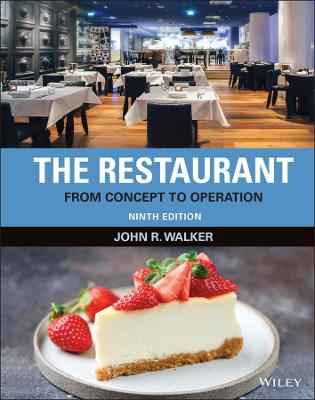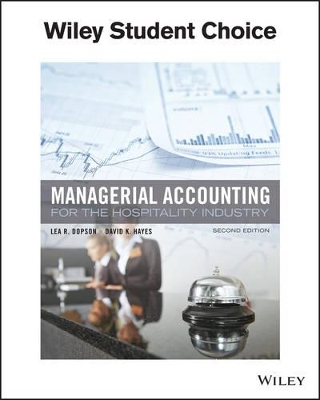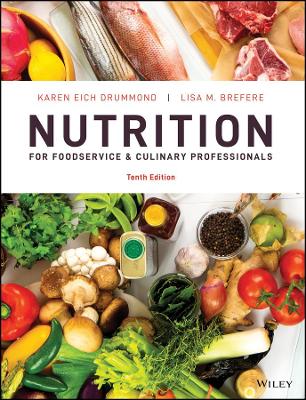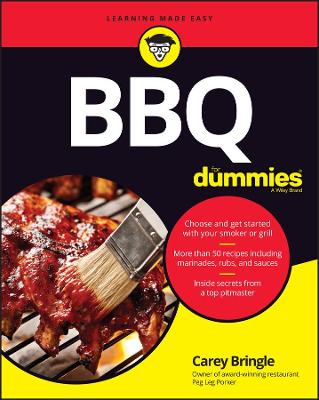Restaurant
 -15%
portes grátis
-15%
portes grátis
Restaurant
From Concept to Operation
Walker, John R.
John Wiley & Sons Inc
03/2022
432
Dura
Inglês
9781119762164
15 a 20 dias
1108
Descrição não disponível.
Preface vii
Acknowledgments xi
Part One Restaurants, Owners, Locations, and Concepts 1
Chapter 1 Introduction 3
Early History of Eating Out 5
French Culinary History 6
Birth of Restaurants in America 7
Challenges of Restaurant Operation 14
Buy, Build, Franchise, or Manage? 16
Starting from Scratch 19
Restaurants as Roads to Riches 20
The Panera and Chipotle Effect 20
Restaurant Organization 21
Reasons Why People Go into the Restaurant Business 21
Chapter 2 Restaurants and Their Owners 26
Kinds and Characteristics of Restaurants 27
Sandwich Shops 30
Quick-Service Restaurants 31
Fast-Casual Restaurants 33
Family Restaurants 34
Casual Restaurants 34
Fine-Dining Restaurants 36
Hotel Restaurants 36
Steakhouses 37
Seafood Restaurants 40
Ethnic Restaurants 41
Theme Restaurants 43
Coffee Shops 45
Post-COVID-19 Ownership 46
Chef-Owned Restaurants 46
Celebrity Chefs 49
Centralized Home Delivery Restaurants 52
Chapter 3 Concept, Location, and Design 57
Restaurant Concepts 58
Defining the Concept and Market 63
Successful Restaurant Concepts 64
Restaurant Life Cycles 68
Concept Adaptation 69
Restaurant Symbology 71
Multiple-Concept Chains 72
Sequence of Restaurant Development: From Concept to Opening 72
Planning Services 73
Common Denominators of Restaurants 74
Mission Statement 81
Concept and Location 82
Criteria for Locating a Restaurant 82
Location Information Checklist 93
Part Two Restaurant Management 97
Chapter 4 The Menu 99
Considerations in Planning a Menu 100
Capability/Consistency 102
Equipment Capacity and Layout 102
Availability of Ingredients 102
Price and Pricing Strategy 103
Nutritional Value 106
Flavor 111
Accuracy in Menus 111
Menu Items 113
Menu Types 116
Menu Engineering 119
Menu Design and Layout 120
Standardized Recipes 122
Menu Trends 124
Chapter 5 Restaurant Business and Marketing Plans 128
What Business Entity Is Best? 129
Buy-Sell Agreement with Partners 134
Legal Aspects of Doing Business 134
Business Plan 138
The Difference between Marketing and Sales 141
Marketing Planning and Strategy 141
Market Assessment, Demand, Potential, and Competition Analysis 145
Marketing Mix-The Four Ps 147
Chapter 6 Restaurant Leadership and Management 161
Leading Employees 162
The Nature of Leadership 164
Employee Input, and What's in It for Me? 165
Policies and Procedures 166
Management Topics 166
Restaurant Management Issues 171
Chapter 7 Planning and Equipping the Kitchen 185
Back-of-the-House Green 188
Open Kitchen 189
Kitchen Floor Coverings 192
Kitchen Equipment 192
Equipment Stars 196
Maintaining Kitchen Equipment 204
Meeting with the Health Inspector 206
Chapter 8 Food Purchasing 209
Sustainable Purchasing 210
Food-Purchasing System 214
Types of Purchasing 217
Buying Meat 218
Buying Fresh Fruits and Vegetables 220
Chapter 9 Financing and Leasing 227
Financing 228
Sufficient Capital 228
Preparing for the Loan Application 229
Uniform System of Accounts for Restaurants 236
Securing a Loan 241
Leasing 250
What Is a Restaurant Worth? 256
Part Three Restaurant Operations 261
Chapter 10 Bar and Beverages 263
Alcoholic Beverage Licenses 264
Bar Layout and Design 266
Beverages 267
Bartenders 272
Basic Bar Inventory 272
Wines 274
Responsible Alcoholic Beverage Service 283
Third-Party Liability 284
Controls 284
Coffee and Tea 285
Chapter 11 Budgeting and Control 290
Restaurant Operations 291
Front of the House 291
Back of the House 296
Control 298
Inventory Control 299
Food Costing 300
Liquor Control 301
Controllable Expenses 304
Labor Costs 305
Labor Management 310
New Overtime Rule 310
Financial Reporting 311
E-Learning 311
Guest Check Control 311
Productivity Analysis and Cost Control 312
Chapter 12 Food Production and Sanitation 316
Our Culinary Heritage 317
Native American Influence 317
African-American Influence 318
Italian Influence 318
French Influence 318
Receiving 322
Storage 323
Food Production 324
Production Procedures 327
Staffing and Scheduling 328
Foodborne Illness 328
Hazard Analysis of Critical Control Points 335
Common Food Safety Mistakes 337
Approaches to Food Safety 338
Food Protection as a System 339
Chapter 13 Organization, Recruiting, and Staffing 345
Job Descriptions 346
Organizing People and Jobs 349
Staffing the Restaurant 349
Civil Rights Laws 359
Questions to Avoid on the Application Form and During the Interview 361
Careful Selection of Staff 365
Chapter 14 Training and Service 371
Orientation 372
Part-Time Employees 373
Training and Development 373
Methods for Training Employees 381
Service 384
Tact: Always 395
Glossary G-1
Index I-1
Acknowledgments xi
Part One Restaurants, Owners, Locations, and Concepts 1
Chapter 1 Introduction 3
Early History of Eating Out 5
French Culinary History 6
Birth of Restaurants in America 7
Challenges of Restaurant Operation 14
Buy, Build, Franchise, or Manage? 16
Starting from Scratch 19
Restaurants as Roads to Riches 20
The Panera and Chipotle Effect 20
Restaurant Organization 21
Reasons Why People Go into the Restaurant Business 21
Chapter 2 Restaurants and Their Owners 26
Kinds and Characteristics of Restaurants 27
Sandwich Shops 30
Quick-Service Restaurants 31
Fast-Casual Restaurants 33
Family Restaurants 34
Casual Restaurants 34
Fine-Dining Restaurants 36
Hotel Restaurants 36
Steakhouses 37
Seafood Restaurants 40
Ethnic Restaurants 41
Theme Restaurants 43
Coffee Shops 45
Post-COVID-19 Ownership 46
Chef-Owned Restaurants 46
Celebrity Chefs 49
Centralized Home Delivery Restaurants 52
Chapter 3 Concept, Location, and Design 57
Restaurant Concepts 58
Defining the Concept and Market 63
Successful Restaurant Concepts 64
Restaurant Life Cycles 68
Concept Adaptation 69
Restaurant Symbology 71
Multiple-Concept Chains 72
Sequence of Restaurant Development: From Concept to Opening 72
Planning Services 73
Common Denominators of Restaurants 74
Mission Statement 81
Concept and Location 82
Criteria for Locating a Restaurant 82
Location Information Checklist 93
Part Two Restaurant Management 97
Chapter 4 The Menu 99
Considerations in Planning a Menu 100
Capability/Consistency 102
Equipment Capacity and Layout 102
Availability of Ingredients 102
Price and Pricing Strategy 103
Nutritional Value 106
Flavor 111
Accuracy in Menus 111
Menu Items 113
Menu Types 116
Menu Engineering 119
Menu Design and Layout 120
Standardized Recipes 122
Menu Trends 124
Chapter 5 Restaurant Business and Marketing Plans 128
What Business Entity Is Best? 129
Buy-Sell Agreement with Partners 134
Legal Aspects of Doing Business 134
Business Plan 138
The Difference between Marketing and Sales 141
Marketing Planning and Strategy 141
Market Assessment, Demand, Potential, and Competition Analysis 145
Marketing Mix-The Four Ps 147
Chapter 6 Restaurant Leadership and Management 161
Leading Employees 162
The Nature of Leadership 164
Employee Input, and What's in It for Me? 165
Policies and Procedures 166
Management Topics 166
Restaurant Management Issues 171
Chapter 7 Planning and Equipping the Kitchen 185
Back-of-the-House Green 188
Open Kitchen 189
Kitchen Floor Coverings 192
Kitchen Equipment 192
Equipment Stars 196
Maintaining Kitchen Equipment 204
Meeting with the Health Inspector 206
Chapter 8 Food Purchasing 209
Sustainable Purchasing 210
Food-Purchasing System 214
Types of Purchasing 217
Buying Meat 218
Buying Fresh Fruits and Vegetables 220
Chapter 9 Financing and Leasing 227
Financing 228
Sufficient Capital 228
Preparing for the Loan Application 229
Uniform System of Accounts for Restaurants 236
Securing a Loan 241
Leasing 250
What Is a Restaurant Worth? 256
Part Three Restaurant Operations 261
Chapter 10 Bar and Beverages 263
Alcoholic Beverage Licenses 264
Bar Layout and Design 266
Beverages 267
Bartenders 272
Basic Bar Inventory 272
Wines 274
Responsible Alcoholic Beverage Service 283
Third-Party Liability 284
Controls 284
Coffee and Tea 285
Chapter 11 Budgeting and Control 290
Restaurant Operations 291
Front of the House 291
Back of the House 296
Control 298
Inventory Control 299
Food Costing 300
Liquor Control 301
Controllable Expenses 304
Labor Costs 305
Labor Management 310
New Overtime Rule 310
Financial Reporting 311
E-Learning 311
Guest Check Control 311
Productivity Analysis and Cost Control 312
Chapter 12 Food Production and Sanitation 316
Our Culinary Heritage 317
Native American Influence 317
African-American Influence 318
Italian Influence 318
French Influence 318
Receiving 322
Storage 323
Food Production 324
Production Procedures 327
Staffing and Scheduling 328
Foodborne Illness 328
Hazard Analysis of Critical Control Points 335
Common Food Safety Mistakes 337
Approaches to Food Safety 338
Food Protection as a System 339
Chapter 13 Organization, Recruiting, and Staffing 345
Job Descriptions 346
Organizing People and Jobs 349
Staffing the Restaurant 349
Civil Rights Laws 359
Questions to Avoid on the Application Form and During the Interview 361
Careful Selection of Staff 365
Chapter 14 Training and Service 371
Orientation 372
Part-Time Employees 373
Training and Development 373
Methods for Training Employees 381
Service 384
Tact: Always 395
Glossary G-1
Index I-1
Este título pertence ao(s) assunto(s) indicados(s). Para ver outros títulos clique no assunto desejado.
restaurant textbook; restaurant business guide; restaurant guide; opening a restaurant; building a restaurant; buying a restaurant; planning a restaurant; restaurant profiles; restaurant case studies; restaurant business; restaurant operations
Preface vii
Acknowledgments xi
Part One Restaurants, Owners, Locations, and Concepts 1
Chapter 1 Introduction 3
Early History of Eating Out 5
French Culinary History 6
Birth of Restaurants in America 7
Challenges of Restaurant Operation 14
Buy, Build, Franchise, or Manage? 16
Starting from Scratch 19
Restaurants as Roads to Riches 20
The Panera and Chipotle Effect 20
Restaurant Organization 21
Reasons Why People Go into the Restaurant Business 21
Chapter 2 Restaurants and Their Owners 26
Kinds and Characteristics of Restaurants 27
Sandwich Shops 30
Quick-Service Restaurants 31
Fast-Casual Restaurants 33
Family Restaurants 34
Casual Restaurants 34
Fine-Dining Restaurants 36
Hotel Restaurants 36
Steakhouses 37
Seafood Restaurants 40
Ethnic Restaurants 41
Theme Restaurants 43
Coffee Shops 45
Post-COVID-19 Ownership 46
Chef-Owned Restaurants 46
Celebrity Chefs 49
Centralized Home Delivery Restaurants 52
Chapter 3 Concept, Location, and Design 57
Restaurant Concepts 58
Defining the Concept and Market 63
Successful Restaurant Concepts 64
Restaurant Life Cycles 68
Concept Adaptation 69
Restaurant Symbology 71
Multiple-Concept Chains 72
Sequence of Restaurant Development: From Concept to Opening 72
Planning Services 73
Common Denominators of Restaurants 74
Mission Statement 81
Concept and Location 82
Criteria for Locating a Restaurant 82
Location Information Checklist 93
Part Two Restaurant Management 97
Chapter 4 The Menu 99
Considerations in Planning a Menu 100
Capability/Consistency 102
Equipment Capacity and Layout 102
Availability of Ingredients 102
Price and Pricing Strategy 103
Nutritional Value 106
Flavor 111
Accuracy in Menus 111
Menu Items 113
Menu Types 116
Menu Engineering 119
Menu Design and Layout 120
Standardized Recipes 122
Menu Trends 124
Chapter 5 Restaurant Business and Marketing Plans 128
What Business Entity Is Best? 129
Buy-Sell Agreement with Partners 134
Legal Aspects of Doing Business 134
Business Plan 138
The Difference between Marketing and Sales 141
Marketing Planning and Strategy 141
Market Assessment, Demand, Potential, and Competition Analysis 145
Marketing Mix-The Four Ps 147
Chapter 6 Restaurant Leadership and Management 161
Leading Employees 162
The Nature of Leadership 164
Employee Input, and What's in It for Me? 165
Policies and Procedures 166
Management Topics 166
Restaurant Management Issues 171
Chapter 7 Planning and Equipping the Kitchen 185
Back-of-the-House Green 188
Open Kitchen 189
Kitchen Floor Coverings 192
Kitchen Equipment 192
Equipment Stars 196
Maintaining Kitchen Equipment 204
Meeting with the Health Inspector 206
Chapter 8 Food Purchasing 209
Sustainable Purchasing 210
Food-Purchasing System 214
Types of Purchasing 217
Buying Meat 218
Buying Fresh Fruits and Vegetables 220
Chapter 9 Financing and Leasing 227
Financing 228
Sufficient Capital 228
Preparing for the Loan Application 229
Uniform System of Accounts for Restaurants 236
Securing a Loan 241
Leasing 250
What Is a Restaurant Worth? 256
Part Three Restaurant Operations 261
Chapter 10 Bar and Beverages 263
Alcoholic Beverage Licenses 264
Bar Layout and Design 266
Beverages 267
Bartenders 272
Basic Bar Inventory 272
Wines 274
Responsible Alcoholic Beverage Service 283
Third-Party Liability 284
Controls 284
Coffee and Tea 285
Chapter 11 Budgeting and Control 290
Restaurant Operations 291
Front of the House 291
Back of the House 296
Control 298
Inventory Control 299
Food Costing 300
Liquor Control 301
Controllable Expenses 304
Labor Costs 305
Labor Management 310
New Overtime Rule 310
Financial Reporting 311
E-Learning 311
Guest Check Control 311
Productivity Analysis and Cost Control 312
Chapter 12 Food Production and Sanitation 316
Our Culinary Heritage 317
Native American Influence 317
African-American Influence 318
Italian Influence 318
French Influence 318
Receiving 322
Storage 323
Food Production 324
Production Procedures 327
Staffing and Scheduling 328
Foodborne Illness 328
Hazard Analysis of Critical Control Points 335
Common Food Safety Mistakes 337
Approaches to Food Safety 338
Food Protection as a System 339
Chapter 13 Organization, Recruiting, and Staffing 345
Job Descriptions 346
Organizing People and Jobs 349
Staffing the Restaurant 349
Civil Rights Laws 359
Questions to Avoid on the Application Form and During the Interview 361
Careful Selection of Staff 365
Chapter 14 Training and Service 371
Orientation 372
Part-Time Employees 373
Training and Development 373
Methods for Training Employees 381
Service 384
Tact: Always 395
Glossary G-1
Index I-1
Acknowledgments xi
Part One Restaurants, Owners, Locations, and Concepts 1
Chapter 1 Introduction 3
Early History of Eating Out 5
French Culinary History 6
Birth of Restaurants in America 7
Challenges of Restaurant Operation 14
Buy, Build, Franchise, or Manage? 16
Starting from Scratch 19
Restaurants as Roads to Riches 20
The Panera and Chipotle Effect 20
Restaurant Organization 21
Reasons Why People Go into the Restaurant Business 21
Chapter 2 Restaurants and Their Owners 26
Kinds and Characteristics of Restaurants 27
Sandwich Shops 30
Quick-Service Restaurants 31
Fast-Casual Restaurants 33
Family Restaurants 34
Casual Restaurants 34
Fine-Dining Restaurants 36
Hotel Restaurants 36
Steakhouses 37
Seafood Restaurants 40
Ethnic Restaurants 41
Theme Restaurants 43
Coffee Shops 45
Post-COVID-19 Ownership 46
Chef-Owned Restaurants 46
Celebrity Chefs 49
Centralized Home Delivery Restaurants 52
Chapter 3 Concept, Location, and Design 57
Restaurant Concepts 58
Defining the Concept and Market 63
Successful Restaurant Concepts 64
Restaurant Life Cycles 68
Concept Adaptation 69
Restaurant Symbology 71
Multiple-Concept Chains 72
Sequence of Restaurant Development: From Concept to Opening 72
Planning Services 73
Common Denominators of Restaurants 74
Mission Statement 81
Concept and Location 82
Criteria for Locating a Restaurant 82
Location Information Checklist 93
Part Two Restaurant Management 97
Chapter 4 The Menu 99
Considerations in Planning a Menu 100
Capability/Consistency 102
Equipment Capacity and Layout 102
Availability of Ingredients 102
Price and Pricing Strategy 103
Nutritional Value 106
Flavor 111
Accuracy in Menus 111
Menu Items 113
Menu Types 116
Menu Engineering 119
Menu Design and Layout 120
Standardized Recipes 122
Menu Trends 124
Chapter 5 Restaurant Business and Marketing Plans 128
What Business Entity Is Best? 129
Buy-Sell Agreement with Partners 134
Legal Aspects of Doing Business 134
Business Plan 138
The Difference between Marketing and Sales 141
Marketing Planning and Strategy 141
Market Assessment, Demand, Potential, and Competition Analysis 145
Marketing Mix-The Four Ps 147
Chapter 6 Restaurant Leadership and Management 161
Leading Employees 162
The Nature of Leadership 164
Employee Input, and What's in It for Me? 165
Policies and Procedures 166
Management Topics 166
Restaurant Management Issues 171
Chapter 7 Planning and Equipping the Kitchen 185
Back-of-the-House Green 188
Open Kitchen 189
Kitchen Floor Coverings 192
Kitchen Equipment 192
Equipment Stars 196
Maintaining Kitchen Equipment 204
Meeting with the Health Inspector 206
Chapter 8 Food Purchasing 209
Sustainable Purchasing 210
Food-Purchasing System 214
Types of Purchasing 217
Buying Meat 218
Buying Fresh Fruits and Vegetables 220
Chapter 9 Financing and Leasing 227
Financing 228
Sufficient Capital 228
Preparing for the Loan Application 229
Uniform System of Accounts for Restaurants 236
Securing a Loan 241
Leasing 250
What Is a Restaurant Worth? 256
Part Three Restaurant Operations 261
Chapter 10 Bar and Beverages 263
Alcoholic Beverage Licenses 264
Bar Layout and Design 266
Beverages 267
Bartenders 272
Basic Bar Inventory 272
Wines 274
Responsible Alcoholic Beverage Service 283
Third-Party Liability 284
Controls 284
Coffee and Tea 285
Chapter 11 Budgeting and Control 290
Restaurant Operations 291
Front of the House 291
Back of the House 296
Control 298
Inventory Control 299
Food Costing 300
Liquor Control 301
Controllable Expenses 304
Labor Costs 305
Labor Management 310
New Overtime Rule 310
Financial Reporting 311
E-Learning 311
Guest Check Control 311
Productivity Analysis and Cost Control 312
Chapter 12 Food Production and Sanitation 316
Our Culinary Heritage 317
Native American Influence 317
African-American Influence 318
Italian Influence 318
French Influence 318
Receiving 322
Storage 323
Food Production 324
Production Procedures 327
Staffing and Scheduling 328
Foodborne Illness 328
Hazard Analysis of Critical Control Points 335
Common Food Safety Mistakes 337
Approaches to Food Safety 338
Food Protection as a System 339
Chapter 13 Organization, Recruiting, and Staffing 345
Job Descriptions 346
Organizing People and Jobs 349
Staffing the Restaurant 349
Civil Rights Laws 359
Questions to Avoid on the Application Form and During the Interview 361
Careful Selection of Staff 365
Chapter 14 Training and Service 371
Orientation 372
Part-Time Employees 373
Training and Development 373
Methods for Training Employees 381
Service 384
Tact: Always 395
Glossary G-1
Index I-1
Este título pertence ao(s) assunto(s) indicados(s). Para ver outros títulos clique no assunto desejado.






